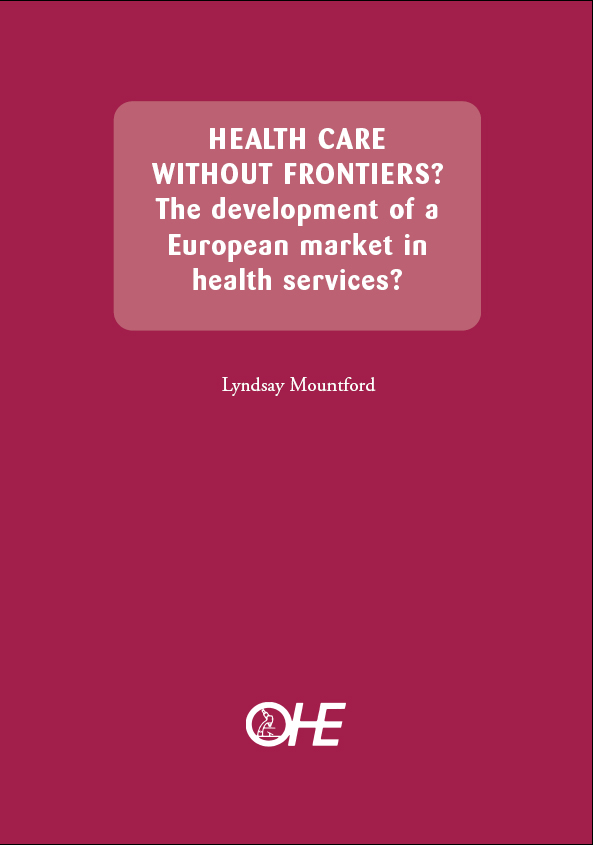Unlocking the Value of Combination Therapies

The purpose of this paper is to set out the background to the development of regulations governing cross-border health care in the EU; to explore the possible implications of the Kohll and Decker rulings (and of subsequent ECJ cases) with particular reference to the experience of cross-border health care in the EU; and to set out some more speculative thoughts on how an internal EU market in health care delivery is likely to develop in the future.
The purpose of this paper is to set out the background to the development of regulations governing cross-border health care in the EU; to explore the possible implications of the Kohll and Decker rulings (and of subsequent ECJ cases) with particular reference to the experience of cross-border health care in the EU; and to set out some more speculative thoughts on how an internal EU market in health care delivery is likely to develop in the future.
The paper is the result of two stages of informal investigation. Initial desk study gave rise to a seminar paper, now incorporated into the text below. This reviewed the development of regulations governing cross-border flows of patients within the EU; summarised such analyses of these flows as are contained in the very small literature base; set out the reasoning behind the April 1998 ECJ rulings; and finally gathered together some of the preliminary reactions of representatives of member states’ health ministries. The last element drew on the records of two international meetings held in late 1998. The extant analyses of cross-border flows are based on data which are now somewhat old and of dubious quality, suggesting that an important prerequisite for policy development in this area is the development and utilisation of a much more effective database than currently exists. Nonetheless, three case studies are described in some detail: a study of cross-border flows between France and Italy; an analysis of cross-border flows in the Euregio Meuse-Rhine, part of the Interregional programme of the EU which is directed at strengthening cooperation across borders within the so-called Euregios, namely the border regions of EU member states; and a survey of frontier workers’ attitudes to cross-border care between France and Belgium.
A second short phase of informal research was defined by an interim seminar held by the Office of Health Economics in October 1999. The possible impact of the Kohll and Decker rulings depends on whether and to what extent patients will move freely across borders for their health care in the future. In part this will depend on new rulings of the ECJ which could extend further the limited scope for cross-border transactions established by the Kohll and Decker cases. The seminar also agreed that, subject to these rulings, a range of drivers and incentives might impact on patient flows and that these should be considered in relation to all the key stakeholders in the process:
● payers: how insurance funds and government payers are reacting to Kohll and Decker and whether they see these rulings as a threat or an opportunity;
● providers: what incentives do providers have as a result of the rulings to set up facilities to attract patients across borders. Is there evidence of this happening?
● patients: the literature already encompasses a number of hypotheses about what factors will predict patient flows, a qualitative summary of which is set out below, particularly with reference to the Euregio Meuse-Rhine study. The findings of a study of migrant workers on the borders of France and Belgium also provide some insight into what motivates patients to move across borders for health care6. In addition to this literature-based evidence, there was also anecdotal evidence that groups representing patient interests might be active in promoting cross-border health care.
In order to explore these questions further, the second part of the exercise encompassed interviews with a number of representatives from provider and payer organisations, as well as discussions with other commentators concerned with a pan-European view of future health service delivery and planning. These interviews concentrated in particular on the most recent phase of several ongoing Euregio health cooperation projects involving The Netherlands, Belgium and Germany. These projects were identified by the OHE seminar as potentially crucial for the future development of regional European health care markets, and as important test beds for exploring the impact of cross-country trading in health services. Interviews were conducted with a number of people involved in the Euregio Meuse-Rhine, Euregio Scheldemond and Euregio Rhine-Waal health care projects, all of whom were considering how best to implement the Kohll and Decker rulings. It did not prove possible to locate any patient interest groups focused on this issue. Some anecdotal evidence about the entrepreneurial behaviour of some doctors became available.
The paper is structured in the following way. Chapter 2 sets out the background to the development of the coordination regulations governing patient mobility in the EU. Chapter 3 contains an analysis of the Kohll and Decker judgements, showing how these appeared to overturn the existing regulations, and contains a brief summary of further cases and their possible implications for the liberalisation of cross-border trade in health care. There are two central issues concerning the scope of the judgements: whether and how they apply to all member states’ health systems; and whether they apply to hospital services. As will be seen, the former question is still much in doubt, although a succession of opinions so far have been consistent in ruling hospital care out of the scope of the ECJ’s judgements. Chapter 4 draws together the reactions of many member states in the immediate wake of the Kohll and Decker rulings. Chapter 5 provides an overview of the extent and composition of cross-border flows pre-Kohll and Decker. Chapter 6 draws on case study material in the literature to exemplify and analyse some of the determinants of cross-border patient flows, and some of the issues to which they give rise in a post-Kohll and Decker world. The fieldwork suggests that an internal EU market in health services is most likely to develop, albeit very slowly, as an interaction of the response of market drivers to the liberalisation of trade, within a growing supra-national regulatory framework. A final concluding chapter considers some possible impacts of the main market drivers and how these might come to be monitored and managed at a political level within existing Treaty competences of the EU.
Health Care without Frontiers?
Mountford, L.
(2000) Health Care without Frontiers?. OHE Monograph. Available from https://www.ohe.org/publications/health-care-without-frontiers/
